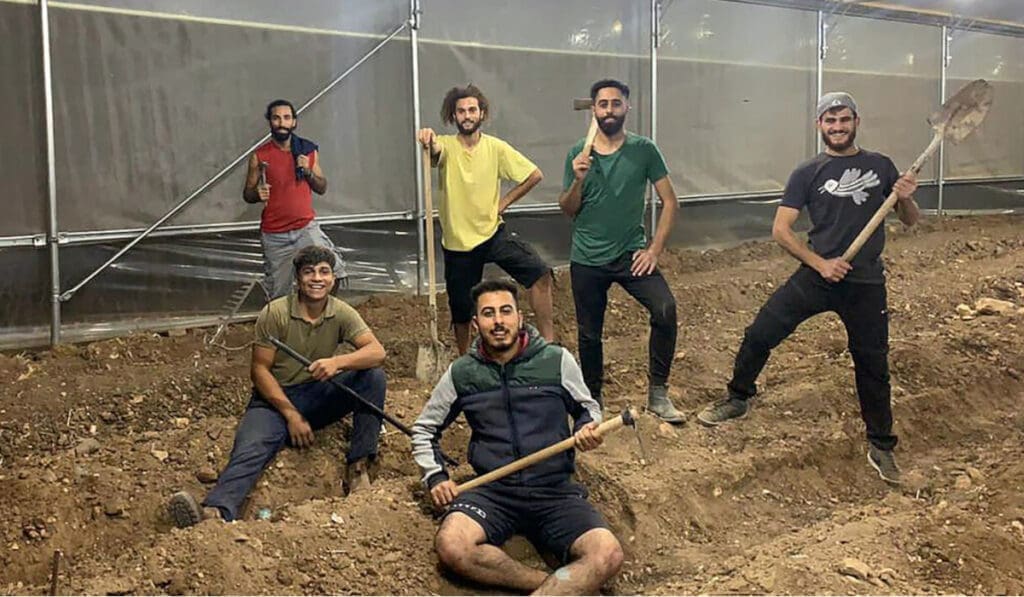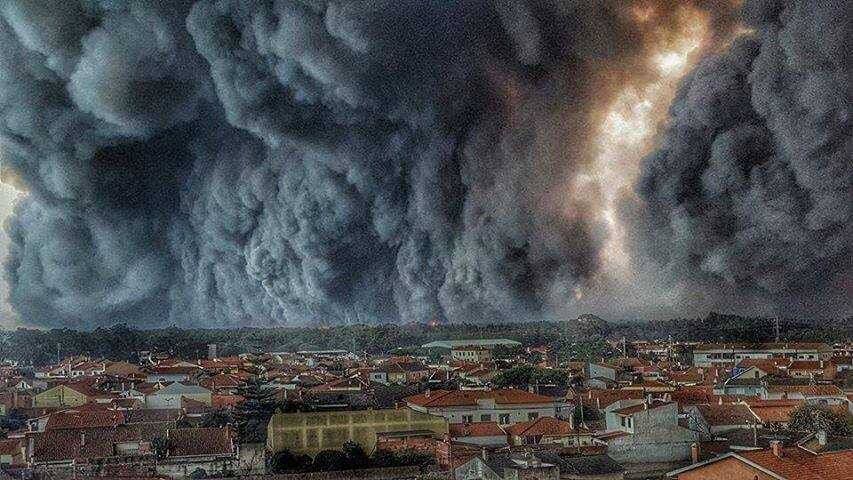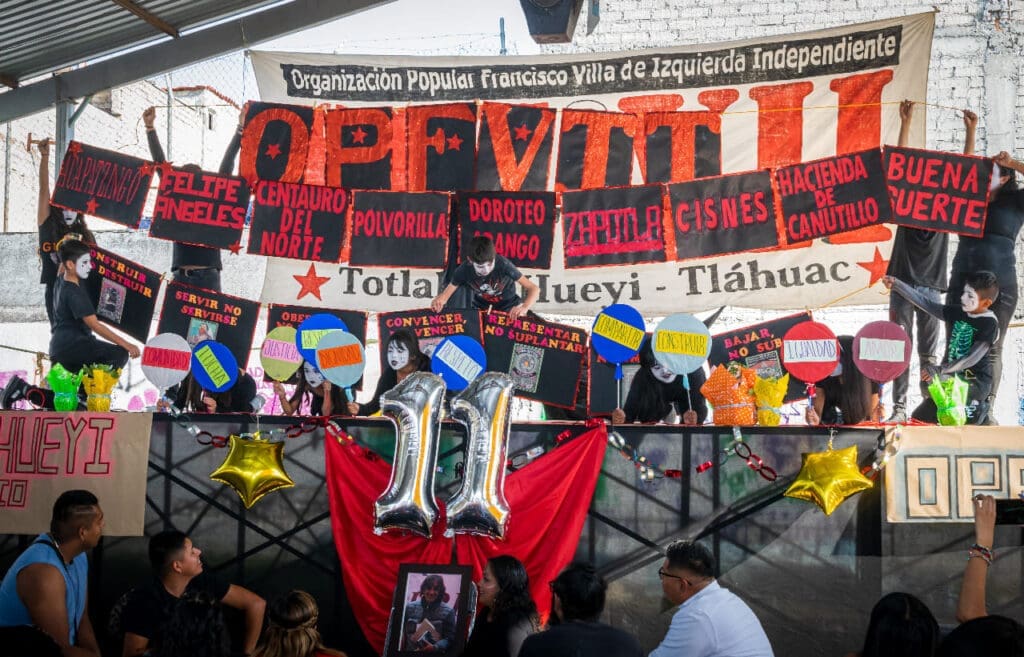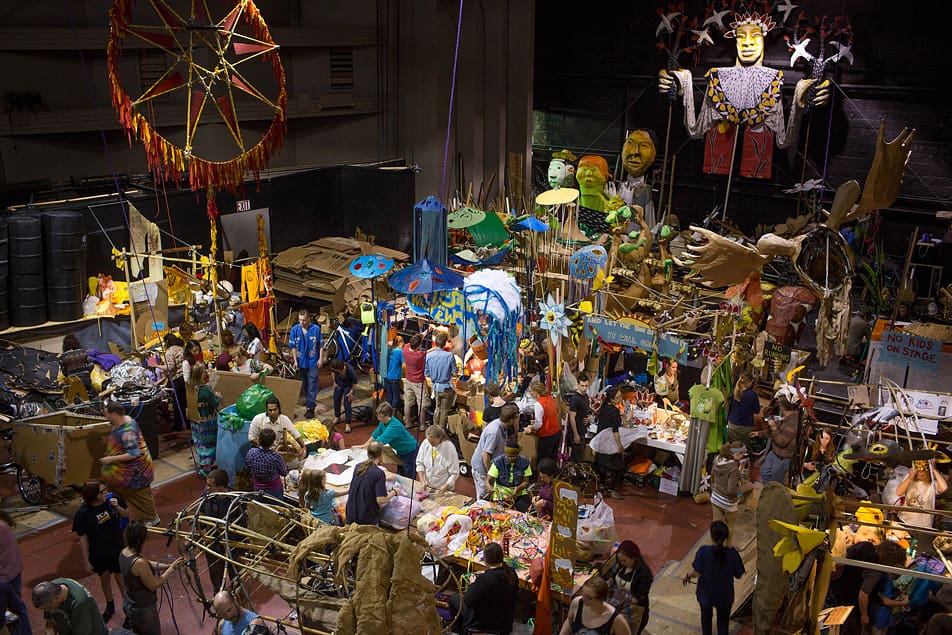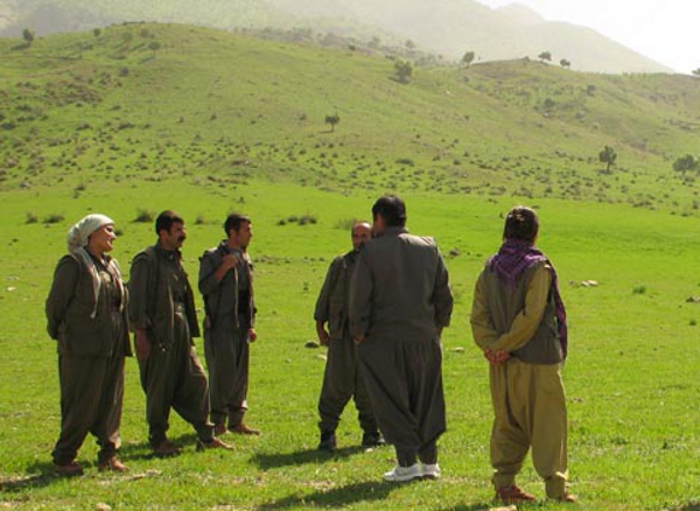AntiNote: The following first appeared on the blog (launched 2020) of the Swiss Society for the Middle East and Islamic Cultures (SSMEIC), which “aims at highlighting the diversity and richness of academic research conducted in Switzerland on Islam, the Middle East, and its connections to Europe.”
We share it here with their as well as the author’s kind blessing.
Youth Cooperatives: An Emergent Model for a Palestinian Resistance Economy
by Faiq Mari for the SSMEIC/SGMOIK/SSMOCI blog (Switzerland)
12 October 2023 (original post)
In the struggle for liberation and dignified work, Palestinian youth return to the concept of Resistance Economy. A successful agricultural cooperative in the Palestinian West Bank serves as their model.
During a rainy night in November 2017, Samer, Adham, Nawras and Qasem gathered in a small shack in Saffa, a village west of Ramallah in the occupied Palestinian West Bank. The four young men were university students who worked day jobs and volunteered in grassroots organizations. Some of them had been involved in an urban cooperative in Ramallah, but that night they concluded that they could do better in rural areas, where land is still available and people retained knowledge of traditional farming techniques.
Huddling in the shack they had converted into their social space, Samer suggested they cultivate a small plot of land that his family owns next to Israel’s apartheid wall among vast village lands threatened by expropriation. A week later the group was ploughing the soil. They followed the advice of Samer’s grandmother to plant peas, and the following March they reaped a good harvest. The profit from the first season encouraged them to continue.
The group called its experiment The Land of Despair Sprouts with Hope, or Ard el-Ya’s in Arabic—Land of Despair for short. Inspired by Friedrich Nietzsche, the name reflects the group’s somber yet determined view of life under occupation and their responsibilities within it: Saffa’s land was under threat of Zionist settlers while their professional prospects vacillated between the Scylla of unemployment and the Charybdis of underpaid wage labor. With Ard el-Ya’s they not only hoped to protect the land and its ecology, but to establish a “resistance economy”—an economy of self-reliance as the basis of a viable Palestinian liberation struggle, and one that offers dignified work opportunities.
Today, Ard el-Ya’s has grown into one of the most successful youth cooperatives and is a catalyst for over twenty similar ones. Its story reflects young people’s recognition of the role of capitalism in the colonization and economic destruction of Palestine as well as their pursuit of alternative economic models. Its perseverance is one of the best examples of what resistance economy in Palestine can accomplish but also highlights its shortcomings. Understanding the potential and limitations of those agricultural experiments is important, not only for the future of Palestine, but also for a world that is suffering from a grave ecological crisis and in need of a path beyond unfettered capitalist growth.
Decades of struggle
The history of resistance economy in Palestine is a tale of colonial destruction, grassroots response, and the realization of the detriments of institutional funding. Its concept is a recent reincarnation of the sumud policies of the 1970s and 1980s. Sumud literally translates to “endurance” and “resilience.” In Palestine, sumud means the ability of the local population to remain on their land despite colonial violence—and above all, the ability of Palestinians to thrive and develop under those conditions.
Sumud’s developmental aspect evolved in response to the economic destruction (or “de-development”) enacted by Israel in the West Bank and Gaza after the occupation of those areas in 1967. In the decades that followed, Israel confiscated vast parts of Palestinian land, destroyed wells and farmland, and began building illegal settlements. Through brute force, taxation, and other policies, Israel gradually suffocated Palestine’s productive sectors, as a consequence of which most Palestinians became wage workers. Agriculture was the sector most harshly affected. According to Leila Farsakh, author of Palestinian Labor Migration to Israel, between 1965 and 1994, thirty percent of agricultural land in the West Bank ceased production.
To counteract this development, Palestinian revolutionary parties in the 1970s and 1980s created an infrastructure of grassroots committees that provided agricultural as well as health- and childcare services. Beyond ensuring Palestinians’ survival on their land, these committees also aimed to enhance people’s living conditions and to mobilize them into a national struggle to liberate the occupied lands.
De-development of the productive sectors in Palestine
One example of such a grassroots organization is the Women’s Work Committee (WWC), founded in 1978. It set up local committees that offered vocational training, childcare, and education to rural women. Medical and agricultural committees followed. During the 1987 Intifada, neighborhoods organized their own local committees. A famous one operated in Beit Sahour, east of Bethlehem: to break the town’s dependence on Israeli imports, the committee purchased eighteen cows to produce their own dairy products. In 2014 this story was chronicled in the Palestinian-Canadian animated documentary film The Wanted 18.
With the Oslo Treaty signed between the Palestinian Liberation Organization (PLO) and Israel in 1993, Palestinians effectively forwent their infrastructure of grassroots service-provision infrastructure in exchange for the promise of self-determination. But the hope Palestinians had in the peace process turned out to be deceiving: not only did Israel gain direct control over the majority of the West Bank and Gaza, but through the Protocol on Economic Relations (the Paris Protocol), the agreements also codified the subordination of the newly formed Palestinian Authority to Israel. While Israel continued and even accelerated its confiscation of Palestinian land and its settlement-building, its policies as well as those of the subordinate Palestinian Authority further de-developed the productive sectors in Palestine, particularly agriculture.
In the year 2000, when Palestinians revolted against the reality brought about by Oslo during the Second Intifada, Israel responded brutally. It invaded Palestinian cities to quell resistance, killing over three thousand Palestinians and destroying whole neighborhoods. Moreover, it confiscated and severed access to fertile lands and wells, and uprooted hundreds of thousands of trees in the countryside.
Following the pressure of Israeli, US, and EU sanctions after the Intifada, in 2006, the Fatah-led Palestinian Authority dismantled any remaining resistance infrastructure and worked on reforming—that is, further neoliberalizing—the Palestinian economy. As a result, living conditions deteriorated for most of the population in the West Bank, and Palestinian workers became even more dependent on the Israeli economy. Between 2007 and 2015 unemployment hovered at around eighteen percent. As shown by a recent Labour Force Survey of the Palestinian Central Bureau of Statistics (PCBS), twenty-five percent of West Bank Palestinian workers earn their living as precarious wage laborers in Israel and its settlements.
Resistance Economy as alternative to the neoliberal policy of the Palestinian Authority
By the end of the 2000s, the detriments of Palestinian economic subordination to Israel became painfully clear, and the voices calling for a sovereign Palestinian economy got louder. Economists who advocated for change now called for the return to sumud practices and presented the concept of resistance economy as an alternative to the then neoliberal policy of the Palestinian Authority. Today’s resistance economy builds on older sumud practices but also learns from their failures: the national-scale committees, like the aforementioned Women’s Work Committee, for example, had emphasized political goals at the expense of economic sustainability. Subsequently, they came to rely on foreign aid, which in turn led to the demobilization of their grassroots structure.
Advocates of resistance economy argue that economic independence is crucial for a successful political liberation struggle: as long as Palestinians remain hostage to Israeli wages or donor money and import their food, they will remain hostage to the fluctuations of a market controlled by Israel. As a result, their political thinking will be limited by their economic interests, and they will never be able to develop the independent political will that is necessary for liberation.
The “Sharaka Youth Forum”
Meanwhile, by the early 2010s some activists were already putting similar ideas into reality. They developed projects with broader national, ecological, or political goals in mind. Cooperative cafes, private permaculture farms, and a handful of similar initiatives started to emerge.
Nevertheless, Ard el-Ya’s, and the group of cooperatives it has inspired, stand out: first because they survived, while most of the previous ones did not. Ard el-Ya’s and most of its fellow cooperatives are profitable: one was able to buy land, others at least break even. Second, and more importantly, their practice conjoins grassroots organizations with a direct responsibility for the local community and an economic goal. In short, their business model enables them to sustain their community service while providing income for themselves.
Two of the founders of Ard el-Yas’s were members of the Sharaka Youth Forum, which brings together Palestinian grassroots groups from the West Bank, Gaza, the lands of 1948 (i.e. what came to be the state of Israel), and from the diaspora. Most of those groups serve their communities as volunteers: they clean streets, defend land against settler expropriation, and offer various free services. However, their funds are limited and their members often unemployed, both hindering their capacity for action.
In events organized by the Forum, Ard el-Ya’s was able to inspire these groups. Between 2018 and 2021 sixteen new cooperatives were formed by Sharaka members. They mostly focus on agriculture, while one is a grocery store. They are spread throughout the West Bank, mainly in the central mountain villages around Ramallah and Nablus; a few are located in the internal plains. Most of their members have received vocational training or higher education and struggled to find jobs. Some have been denied wage labor in Israeli settlements or have refused to accept jobs they felt were degrading. Others pursue the work in the cooperative alongside their studies.
The core values the Sharaka cooperatives have defined for dealing with society, the environment, and with each other are care, justice, equality, and independence. Thus, they mainly sow indigenous seeds and farm staple produce, like vegetables and grains, but also olives, for domestic consumption to support food sovereignty. They have also been experimenting with various ecologically-aware farming practices and philosophies. Most provide food baskets to the needy in their villages and continue to participate in volunteer work. At the same time, the cooperatives maintain a horizontal structure and experiment with management and remuneration models that fit their egalitarian principles. For them, the cooperative is an attempt at living out the freedom they seek for Palestinians.
Farming land helps to protect it from confiscation
It is not a coincidence that these groups turned to agriculture. The land is threatened by expropriation and is subject to recurring settler violence. Farming the land helps to protect it from confiscation. From 1967 to 1979 Israel confiscated Palestinian lands for settlement building through military orders claiming security reasons. After 1979, Israel came to rely on an interpretation of Ottoman law that stipulates that land without “proper registration”—meaning land that is less than fifty percent cultivated—returns to the state. This is one reason settler militias regularly burn fields and cut down trees on Palestinian lands. At the same time, the colonial violence that led farmers to desert their land made it available for active youth to cultivate it, even if under tough conditions.
Furthermore, the focus on agriculture and environmentally conscious practices reflect the increased attention Palestinian activists pay to the environment as well as the influence of global movements for peasant rights, agro-ecology, and degrowth. These youths are increasingly aware that the capitalist model fueling Israeli colonization, of which cheap settlement labor is one facet and unemployment another, is the same that drives the planet to extinction. Finding non-capitalist ways to provide basic needs, especially food, seems to many of them an alternative starting point.
The cooperative model makes sense as well. It allows the pooling of resources, while the collective nature of its labor fits the requirements of agricultural work as well as the desires of those young people alienated in wage jobs. The location of the cooperatives further testifies to their objectives: when the Ard el-Fallahin cooperative started in 2019, it targeted village lands next to a spring threatened by settlers. Most of the other cooperatives farmed lands on the frontlines of Israeli-Palestinian confrontation, namely in Area C, which comprises the majority of the West Bank, and falls under the military and civic administration of Israel.
Today, as the extreme-right Israeli government has emboldened the settler community to increase violent attacks on Palestinian lives and property, the cooperatives find themselves under recurrent threats. Nevertheless, Samer, one of the founders of Ard el-Ya’s, says this doesn’t stop them: “Some days I think to myself: Damn this country, it’s all too much,” he says. “Then I remember the land and it gives me a sense of safety. There is nothing like it.”
The financial challenge
While many of the Sharaka cooperatives are only minimally profitable, the number of their members remain constant even when other work opportunities arise. For the Sharaka group, sentimental motivation and the broader purpose of the work trump financial considerations. However, the more strategically-minded members realize that for such a model to flourish, it needs to offer a decent source of income: if cooperatives intend to provide Palestinian wage workers an alternative to the humiliating labor in Israeli settlements, they need to be able to compete with it.
This is not an easy task. There are 1,250 registered cooperatives in the West Bank, of which only 350 are active (meaning that they have set a budget and convened a general assembly meeting at least once in the past three years), and of which 147 are agricultural. The Sharaka group includes twenty youth cooperatives, which is quite a large number in comparison.
What makes the task of youth cooperatives more difficult is the fact that Sharaka cooperatives insist on self-reliance and avoid NGO funding. The reason for this resolute stance is the lesson learned from the experience of the 1980s committees: after the Oslo Treaty, they had transformed into NGOs that increasingly became more accountable to their funders than to their popular base. Thus, Ard el-Ya’s and four other cooperatives collected limited resources and borrowed from family and friends. Later, some started to accept unconditional NGO aid and individual donations, while others declined NGO support altogether.
A major advancement came with the founding of the Palestinian Social Fund in the year 2021. The Fund was initiated by a group of young Palestinians in the diaspora to support the inchoate cooperative movement. It accepts individual donations through its website and funnels them to specific cooperative projects. It does not accept institutional donations or conditional funding, nor does it impose conditions on the cooperatives it supports. The fund has so far collected roughly 7,000 USD, mostly in small donations under twenty dollars, and has supported projects such as a greenhouse for Ard el-Ya’s.
Today, many of the youth cooperatives realize that they need larger financial investments to be able to survive in the market. A few are falling back into the trap of institutional support, often to their detriment. This happened to two Sharaka cooperatives that merged into one in response to a condition for funding from Oxfam, only to then find themselves in an inoperable state because they had not been ready for the merger.
Other Sharaka cooperatives developed successful alternatives. Some have turned to farming less water- or labor-intensive produce, such as fruit trees and grains, thereby reducing their costs and increasing their labor flexibility. Others are beginning to think of ways to operate outside the market, in circles of product and service barter, so as not to compete with much more powerful agribusiness—mainly subsidized by Israel.
The Sharaka collectives succeeded where others before them failed: they have survived as a model of self-funded community-based organizations that offer community services and generate income for its members. However, the membership in each cooperative remains relatively low—hardly exceeding ten people—and they are yet to offer a lucrative source of income that is a generalizable alternative to settlement labor. Will these cooperatives be able to expand and replicate or will they remain marginal islands for idealist youth?
The answer will depend on the ingenuity of their members, but also on the solidarity network that can support them, both within Palestinian society and internationally. Crowdfunding and solidarity campaigns might indeed be able to kickstart a self-sustaining economic model that no longer relies on aid. Even so, success is not guaranteed. Nonetheless these cooperatives offer an avenue that is well worth pursuing at a time when the outlook for the Palestinian cause, and indeed the planet, seems uncertain.
Faiq Mari is a doctoral candidate at the Department of Architecture, ETH Zurich. His dissertation studies the concept and practice of masha’, or collective labor and property, within Palestinian liberation struggle. He is an architect and has previously taught at Birzeit and Al-Quds universities in Palestine.
Further readings:
Clarno, Andy. “Neoliberal Colonization in the West Bank.” Social Problems 65/3, 2018, pp. 323-341.
Dana, Tariq; Tartir, Alaa; and Seidel, Timothy. Political Economy of Palestine: Critical, Interdisciplinary, and Decolonial Perspectives. London: Palgrave Macmillan, 2021. doi:10.1007/978-3-030-68643-7.
Farsakh, Leila. Palestinian Labour Migration to Israel: Labour, Land and Occupation. London: Routledge, 2012.
Farsakh, Leila. “Palestinian Economic Development: Paradigm Shifts since the First Intifada.” Journal of Palestine Studies 45/2, 2016, pp. 55–71.
Haddad, Toufic. “Neoliberalism and Palestinian Development: Assessment and Alternatives.” In: Tabar, Linda and Salamanca, Omar (eds.) Critical Readings of Development under Colonialism: Towards a Political Economy for Liberation in the Occupied Palestinian Territories. Rosa Luxemburg Stiftung Regional Office Palestine, 2015, pp. 34-67;
Hiltermann, Joost R. Behind the Intifada: Labor and Women’s Movements in the Occupied Territories. Princeton: Princeton University Press, 1993.
Radi, Tareq. 2022. “Cultivating Credit: Financialized Urbanization Is Alienation!” Journal of Palestine Studies 51/1, 2022, pp. 4–26.
Schaeublin, Emanuel. “Disconnected Accountabilities.” Journal of Muslim Philanthropy & Civil Society 4/2, 2020, pp. 28-60.
Featured image: Ard el-Ya’s members pose for a picture in one of their green houses in Saffa. Source: Ard el-Ya via the SSMEIC

